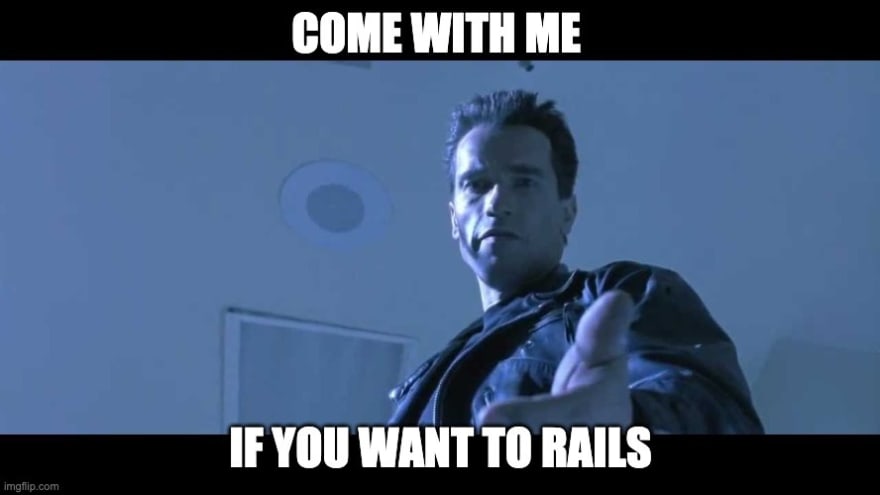When I began coding with Rails only 3 weeks ago, I could state with confidence that I only understood about 20 percent of the reading material. The firehose of information was opened to max, and I had about two weeks to understand it all before our code challenge.
It was a lot of information, so I buckled down, read, and re-read the key READMEs, rewatched old lectures to the point that I found myself asking questions to my instructor from 4 days ago. In the end, I overcame, and passed! With this new albeit short feeling of triumph, I decided to write this post with some fundamental Rails commands to streamline your programming process.
Basic MVC Architecture
Model View Controller or MVC is a software design pattern for developing web applications.
- Model - Responsible for maintaining data.
- View - Presents all or some data to the User
- Controller - Responds to user input and performs interactions between models and views
Create a new application
Install the Rails gem if you haven't done so before
$ gem install rails
Generate a new Rails app
$ rails new my-app
Initialize the database
$ rake db:create
Start the Rails server
$ rails s
Routes
Create a route that maps a URL to the controller action
# config/routes.rb
get 'welcome' => 'pages#home'
Shorthand for connecting a route to a controller/action
# config/routes.rb
get 'photos/show'
# The above is the same as:
get 'photos/show', :to 'photos#show'
get 'photos/show' => 'photos#show'
Similarly, you can create all the RESTful routes for a resource by simply...
# config/routes.rb
resources :photos
| HTTP Verb | Path | Controller#Action | Used for |
|---|---|---|---|
| GET | /photos | photos#index | display a list of all photos |
| GET | /photos_new | photos#new | return an HTML form for creating a new photo |
| POST | /photos | photos#create | create a new photo |
| GET | /photos/:id | photos#show | display a specific photo |
| GET | /photos/:id/edit | photos#edit | return an HTML form for editing a photo |
| PATCH/PUT | /photos/:id | photos#update | update a specific photo |
| DELETE | /photos/:id | photos#destroy | delete a specific photo |
Create resources for specific actions...
# config/routes.rb
resources :photos, only: [:index]
Create a route to a static view, without an action in the controller
# config/routes.rb
# If there's a file called 'about.html.erb' in 'app/views/photos', this file will be
# automatically rendered when you call localhost:3000/photos/about
get 'photos/about', to: 'photos#about'
Reference: http://guides.rubyonrails.org/routing.html
Controllers
Generate a new controller
Attention: Capitalize controller names and pluralize
$ rails g controller Photos
You can generate a new controller with default actions, routes and views
$ rails g controller Photos index show
Reference: http://guides.rubyonrails.org/action_controller_overview.html
Models
Generate a model and create a migration for each table
Attention: Capitalize model names and singular
$ rails g model Photo
Generate a model and create a migration with table columns
$ rails g model Photo location:string description:text
The migration automatically created for the above command:
class CreatePhotos < ActiveRecord::Migration
def change
create_table :photos do |t|
t.string :location
t.text :description
t.timestamps null: false
end
end
end
Reference: http://guides.rubyonrails.org/active_model_basics.html
Migrations
Migration Data Types
:boolean:date:datetime:decimal:float:integer:primary_key:references:string:text:time:timestamp
Scaffolding
Scaffolding is great for prototypes but don't rely too heavily on it. Here's a good explanation on why: http://stackoverflow.com/a/25140503
$ rails g scaffold Photo location:string description:text
$ rake db:migrate
Rake
View all the routes in an application
$ rake routes
Seed the database with sample data from db/seeds.rb
$ rake db:seed
Run any pending migrations
$ rake db:migrate
Rollback the last migration performed
ATTENTION: Keep in mind that this command is destructive and you could lose your data. Make sure you run any pending migrations and re-seed after making the appropriate changes.
$ rake db:rollback
...will rollback your migrations one step.
$ rake db:rollback STEP=n
...will rollback your migrations n number of steps.
Path Helpers
Creating a path helper for a route
# Creating a path helper for a route
get '/photos/:id', to: 'photos#show', as: 'photo'
# app/controllers/photos_controller.rb
def show
@photo = Photo.find(params[:id])
end
# View for the action
<%= link_to 'Photo View Page', photo_path(@photo) %>
Once again, path helpers are automatically created when specifying a resource in config/routes.rb
# config/routes.rb
resources :photos
For example, let's look at all the RESTful routes for photos
| HTTP Verb | Path | Controller#Action | Named Helper |
|---|---|---|---|
| GET | /photos | photos#index | photos_path |
| GET | /photos/new | photos#new | new_photo_path |
| POST | /photos | photos#create | photos_path |
| GET | /photos/:id | photos#show | photo_path(:id) |
| GET | /photos/:id/edit | photos#edit | edit_photo_path(:id) |
| PATCH/PUT | /photos/:id | photos#update | photo_path(:id) |
| DELETE | /photos/:id | photos#destroy | photo_path(:id) |
Form Helpers
Connect a form to a model for creating or updating a resource.
Use this method if you're using strong params to protect against mass assignment.
Some helpful documentation on strong params and mass assignment: https://ropesec.com/articles/mass-assignment/
# app/controllers/photos_controller.rb
def new
@photo = Photo.new
end
# app/controllers/photos_controller.rb
def create
@photo = Photo.new(params.require(:photo).permit(:description, :location)
Photo.save
redirect_to photo_path(@photo)
end
# ERB view
<%= form_for @photo do |f| %>
<%= f.text_field :location %>
<%= f.text_area :description, size: "60x12" %>
<%= f.submit "Submit" %>
<% end %>
And there you have it! Use this guide to help you understand the different rails commands to help you create your MVC along with RESTful routes for your Models.
References: [http://guides.rubyonrails.org/form_helpers.html]
[http://www.pragtob.info/rails-beginner-cheatsheet/]




Top comments (0)